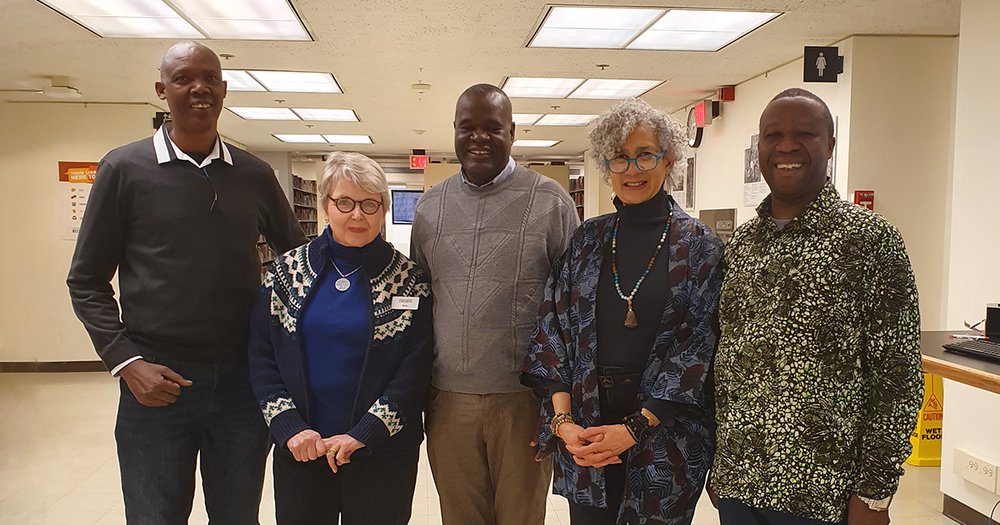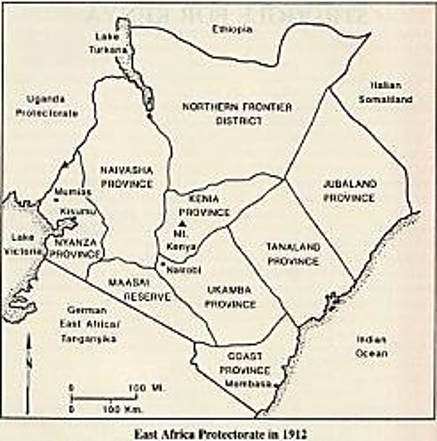Kenya National Archives

by Bonnie Ryan, recently retired Librarian for Africa/African American Studies

Struggle for Kenya, Robert Maxson 1993, 18
“I would like to investigate the colonial government in the Northeastern Frontier district or province of Kenya in the early 20th century, focusing on education policies.”
“I would like to look at land tenure disputes in the Nyanza Province…”
Two questions above are examples of the type of research that leads scholars to Syracuse University Libraries’ Kenya National Archive collections.
What are the Kenya National Archives?
The Kenya archive collections comprise a large variety of materials which are mostly primary source government documents. Many of the materials were at one time confidential and belonged to the colonial government of Kenya up to the early 1960’s. Other types of materials include a large number of microfilm reels of newspapers, journals, and papers of assorted social organizations. Syracuse University Library is the sole repository for the complete collection on the Kenya National Archive of materials up to the time of independence from colonial rule in Kenya. Duplicates of selected portions of the collection are held at various other archival institutions around the world, including the Center for Research Libraries (CRL) in Chicago; the National Archives of Kenya in Nairobi; the National Archives of Great Britain , London; and some U.S. universities such as University of Michigan and University of Illinois.
Location and Use of the Collection
The Kenya National Archive microfilm collections are currently housed on the 3rd floor of Bird Library in cabinets with other microfilm collections. Microfilm readers/scanners are nearby. When viewing the microfilm, a scholar can download pages onto a USB drive for printing at their leisure. The expert staff at the service desk on the third floor are available to help scholars with any technical or access assistance. Syracuse University Libraries offer Interlibrary Loan to scholars in the continental U.S. for up to 4 reels of the Kenya National Archive collection at a time.
How the collection came to Syracuse
The collection was produced in the 1960’s through a joint grant with the National Science Foundation, the government of Kenya, and the Program of Eastern African Studies of Syracuse University, which is no longer in existence. The East Africa Program was developed in 1962 as a very strong component of the Maxwell School, attracting a number of scholars of the African continent, including Eduardo Mondlane and Fred G. Burke (Gregory 1984). The Kenya documents were microfilmed by Syracuse University faculty in the East Africa Program, their graduate students, and the Chief Archivist of Kenya in the mid-sixties.
The story of how the documents were chosen, found, collected, and received by the scholarly community is full of suspense and political intrigue. It is a lesson in international and scholarly diplomacy. To find a thorough description and history of the collection, look at Robert Gregory’s article in Syracuse University Libraries’ Associates Courier, Vol. XIX, Number 2, Fall 1984, pp. 29-59. You can also view the article through the Syracuse University Libraries’ SURFACE repository. The collection of approximately 1,369 microfilm rolls was then sent to the Syracuse University Libraries in 1966 and 1967 to preserve the records of the colonial government for research purposes.
How the collection is used
Because of the wide diversity of materials within the collections, most of which is not fully indexed, scholars are encouraged to visit Syracuse University Libraries and peruse the collections themselves. To prepare scholars for the collections, many of the indexes that were produced have been digitized, and are part of the Libraries’ digitized collections (Kenya National Archive Guides). On-site orientations are offered to visiting scholars who are using the collections in our Libraries for the first time.
These extremely valuable collections have served a number of scholars from around the world as well as faculty and students at Syracuse University, such as Professor Martin Shanguhyia, Department of History. Dr. Shanguhyia makes extensive use of the collection for his classes as well as for his own research investigations. In any given year, 16-20 scholars from other institutions may access the collection. Every single scholar who has used the collection goes away with more information than they knew existed on their topic and are armed with citations and microfilm numbers to access the KNA sources via Interlibrary Loan or in-person for further research.
Some challenges and closing remarks
There are many challenges facing the future of this rich collection, primarily in terms of preservation and access. One ongoing concern is the gradual deterioration of the quality of the content, given the age and nature of the microfilmed materials. In terms of access, there is also a question of how to make the resources, including their guides and indexes, open and accessible to a wider group of scholars. There is also the real and unresolved issue of ownership and corresponding rights to the documents themselves that must also be discussed between a number of stakeholders around the world, most importantly between Syracuse University and the Kenyan Government.
As Robert Gregory ably described in his 1984 article in the Library Courier, East Africa in general and Kenya in particular is a fascinating study for African scholars. The tensions, often violent, between the occupying colonizers of the British Empire and the struggles of liberation of the peoples of the African nations, such as the Mau Mau revolt in Kenya (Gregory, 1984, 32) are documented in a number of sources. (Maxson 1993) Despite the fact that it is from the perspective of the occupying, colonial forces, the Kenya National Archive collections gives the scholar a glimpse of the effects of British occupation on an African nation and the struggle of Kenya’s citizens to survive and prevail in all its complicated, bureaucratic, and heart-breaking details.
Sources:
Gregory, Robert G. “The Development of the East African Collection at Syracuse University”, The Courier, 19.2 (1984) 29-59
Maxson, Robert M. Struggle for Kenya: The Loss and Reassertion of Imperial Initiative, 1912-1923
1993 Cranbury, N.J.: Associated University Presses
NOTE:
A delegation from the Kenya National Archive visited Syracuse University Libraries from December 9 – 13, 2019 to learn how the Syracuse University collection of the Kenya National Archives is maintained and accessed. The delegation consisted of Mr. Frank Mwangi, Director of the Kenya National Archives, Nairobi and Assistant Directors, Naftal Chweya and Richard Wato. There were an additional three members of the delegation visiting other research institutions in the U.S. at the same time.
Syracuse University Libraries’ employees Darle Balfoort and Bonnie Ryan worked closely with Director Mwangi and Assistant Directors Chweya and Wato to search the Kenya National Archives guides and bibliographies. The delegation also met with Professor Martin Shanguhyia, History Department, and his graduate assistants. Director Mwangi hopes that their visit may open future discussions between the Kenyan government and Syracuse University on the preservation and conservation of the University’s Kenya National Archive collections.
Photo above shows from left: Mr. Richard Wato, Assistant Director, Kenya National Archives; Darle Balfoort, Library Technician and Maps Assistant; Mr. Naftal Chweya, Assistant Director, Kenya National Archives; Bonnie C. Ryan, (recently retired) Social Science Librarian; Mr. Francis Mwangi, Director of Kenya National Archives.
